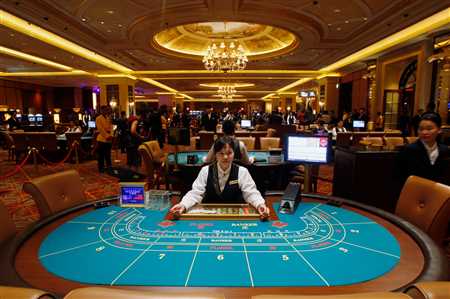

The landscape of wagering has undergone significant transformations in recent years, reshaping the hierarchy of entertainment hubs worldwide. What was once synonymous with a particular city is now being challenged by a dynamic competitor, whose rise has captured the attention of enthusiasts and investors alike. These shifts not only highlight changing preferences but also underscore the evolving regulatory environment nurturing this thriving sector.
While certain regions continue to thrive on the allure of risk and the excitement of chance, others are re-evaluating their stance on automated systems that define the experience. The divergence in approaches across various jurisdictions reveals a complex tapestry of cultural attitudes and economic strategies, as authorities grapple with balancing innovation and control.
As the focus intensifies on in-person experiences and regulatory measures tighten around technological advancements, industry stakeholders must adapt swiftly to remain relevant. This evolving narrative promises new opportunities and challenges, compelling all involved to rethink their strategies and approach in light of the shifting tides of fortune and regulation.
In recent years, a particular region has astoundingly transformed its position within the world of recreational betting, elevating its prominence on a global scale. This shift has not only attracted high-stakes players but also captivated visitors from various corners of the world, seeking thrill and excitement. The combination of lavish venues, exquisite entertainment, and a diverse range of leisure activities has propelled this destination into the spotlight as a premier hub for those eager to explore the world of chance.
The ascent of this locale can be attributed to several factors, including strategic investments in infrastructure and a keen understanding of market demands. State-of-the-art facilities and an ever-expanding array of services have positioned this city as a magnet for tourists and high rollers alike. As competition escalated elsewhere, it became evident that a unique blend of cultural richness and modern attractions played a pivotal role in drawing enthusiasts.
Furthermore, the evolution of regulations has fostered an environment conducive to growth. By allowing diverse forms of entertainment and refining operational standards, this territory has crafted a distinctive identity that sets it apart. The allure of not just gaming, but a comprehensive lifestyle experience, has become a significant draw, ensuring that both new and returning visitors find themselves enchanted.
As this destination continues to thrive, other regions may look to its model for inspiration, hoping to replicate its successes in their own pursuits. The remarkable journey of this locale exemplifies the dynamic nature of the leisure industry, highlighting how adaptability and innovation are essential for achieving long-term dominance.
The journey of wagering establishments has been marked by significant transformations, reflecting cultural shifts and economic changes over the centuries. What began as informal games of chance has evolved into a multifaceted industry encompassing a variety of formats and venues. This section delves into the pivotal moments that have shaped the landscape of risk and reward activities around the world.
By adapting to the preferences and values of society, these establishments have successfully navigated periods of prohibition and acceptance.
As the industry continues to adapt to modern demands and regulations, its evolution remains a compelling narrative of societal trends and individual choices.
The journey from humble beginnings to a position of unparalleled significance in the world of wagering is a fascinating narrative. This evolution outlines not only the history and cultural influences shaping this sector but also the regulatory frameworks that have emerged in response to its rapid growth and popularity. Examining the factors contributing to this transformation reveals the complexity and dynamism of the environment.
Key factors contributing to this ascent include:
Additionally, as the influence of this industry expands, governments have begun implementing measures to control and manage its impact on society. A blend of regulation and oversight aims to balance economic benefits with potential social consequences.
As a result, many regions have witnessed shifts in their approach to digital versus traditional formats, leading to ongoing debates about the future of entertainment in this realm. These discussions underscore the need for a nuanced understanding of local contexts and the global implications of changing paradigms.
This section delves into the prominent entities and their financial commitments shaping the landscape of the entertainment and wagering sectors. As competition intensifies, strategic investments and partnerships emerge as pivotal components driving growth and innovation within these industries.
Leading operators continue to expand their portfolios, focusing on unique offerings and enhanced customer experiences. From cutting-edge technology in virtual experiences to diversification of entertainment options, major stakeholders are reshaping perceptions and expectations.
Moreover, significant investments in infrastructure and development projects reflect confidence in sustained consumer interest. This commitment not only bolsters local economies but also signals an evolving industry eager to adapt to changing regulatory frameworks and consumer preferences.
As this dynamic environment unfolds, the collaboration between established companies and new entrants fosters a landscape ripe for transformation, urging continual evaluation of market strategies and capital allocation.
The tremendous growth of the gaming industry in this vibrant destination can be attributed to a combination of strategic developments, cultural elements, and government policies that have created an appealing environment for both tourists and operators. Understanding these dynamics offers insights into how this locale has eclipsed traditional competitors in attracting players from around the globe.
Strategic Investment has played a pivotal role in transforming the local landscape. Significant financial commitments from private enterprises have resulted in the establishment of world-class facilities, enhancing visitor experiences and drawing in high-roller clientele. This trend showcases how innovative infrastructure and luxurious amenities contribute to increased foot traffic and overall revenue.
Cultural Appeal is another essential factor that drives interest. The unique blend of East and West enriches the atmosphere, making it particularly attractive for international visitors. Traditional festivities, culinary delights, and hospitality create a captivating experience that goes beyond mere wagering activities, enticing patrons to explore and engage.
Regulatory Framework also plays a crucial role. Flexible and favorable regulation encourages business operations while maintaining accountability. By fostering a stable environment for operators, authorities support sustainable growth in the industry, which, in turn, fuels investment and innovation.
Furthermore, an ever-expanding tourism industry significantly boosts the sector. With an influx of visitors from various regions, particularly from neighboring countries, the diverse offerings ensure that there is something to attract every type of traveler, thus increasing participation and expenditure in the local economy.
In summary, the convergence of strategic investment, cultural richness, regulatory support, and tourism dynamics creates a robust ecosystem that sustains the flourishing landscape of this exciting entertainment hub.
Regulatory frameworks play a crucial role in shaping the landscape of the entertainment industry, particularly in areas related to chance and skill-based activities. Authorities implement rules to strike a balance between economic interests, public safety, and ethical considerations. These policies can influence the operation of establishments, define allowable activities, and establish parameters for responsible participation.
Licensing is a key aspect of these regulations, ensuring that operators comply with required standards. This process often involves extensive background checks and financial assessments to promote transparency and integrity within the sector. Additionally, age restrictions and identification protocols are enforced to prevent underage participation, reflecting a commitment to safeguarding vulnerable populations.
Furthermore, localized laws concerning gaming venues can differ significantly across regions. Some jurisdictions may favor a more liberal approach, while others impose stringent limitations on where such activities can occur. These measures aim to control the proliferation of venues and minimize potential social issues associated with excessive participation.
In addressing concerns related to addiction and social impact, many governments have adopted responsible gaming initiatives. These programs often include educational campaigns, self-exclusion options, and resources for individuals seeking help. By prioritizing public welfare, authorities aspire to create a safer environment for all participants.
The growth of tourism and the corresponding advancements in infrastructure play a crucial role in shaping destinations and attracting visitors from around the globe. A thriving tourism sector not only enhances the appeal of a location but also drives economic growth and creates jobs. Well-developed facilities, including transportation networks, hotels, and entertainment venues, contribute significantly to the overall experience of travelers, making it imperative for regions to invest in these areas to capitalize on their potential.
The relationship between an influx of tourists and infrastructure improvements is symbiotic. As more individuals visit a destination, the demand for quality services and amenities increases, prompting local authorities and private investors to enhance facilities and upgrade transportation systems. This cycle not only boosts the local economy but also fosters a vibrant environment that encourages repeat visits, ultimately benefiting all stakeholders involved.
Moreover, strategic planning in the realm of infrastructure can elevate a location’s status as a prime travel destination. Investments in public transportation, airports, and recreational spaces can significantly improve accessibility and comfort for visitors. A well-connected region with diverse attractions caters to various interests and preferences, enhancing its allure and ensuring a sustainable flow of tourists over time.
In summary, the interplay between tourism and infrastructure development is vital for establishing and maintaining prosperous destinations. By fostering a conducive environment through well-planned enhancements, regions can effectively harness the benefits of a thriving tourism industry while ensuring a memorable experience for all who visit.
The shift in the competitive landscape of recreational wagering has significant implications for the financial health and development of the surrounding areas. As one destination emerges as the preferred locale for such activities, it influences job creation, local businesses, and overall economic growth. The interplay between diverse factors, including consumer behavior and regulatory frameworks, shapes the economic fabric of the region.
The influx of tourists drawn to these entertainment hubs stimulates various sectors, such as hospitality, retail, and transportation. Consequently, increased visitor spending generates revenue that supports infrastructure improvements and public services. Moreover, the establishment of new enterprises and the expansion of existing ones contribute to job opportunities for residents, thereby impacting the overall standard of living.
Conversely, limitations imposed on certain activities can redirect consumer spending and alter the competitive dynamics within the industry. As local authorities implement new measures to govern recreational options, businesses must adapt to the evolving environment or face potential decline. Balancing regulation with economic advancement remains crucial for sustaining growth within this sector.
Ultimately, the economic ramifications of these changes extend beyond mere financial metrics, affecting social structures and community welfare. Engaging stakeholders in discussions regarding development strategies can foster a collaborative approach to navigating the complexities of this vibrant economic landscape.